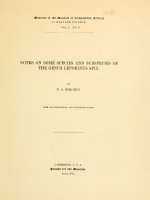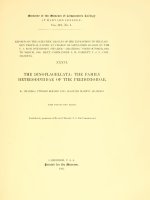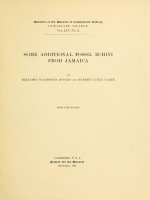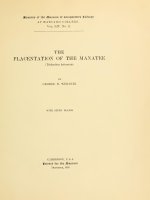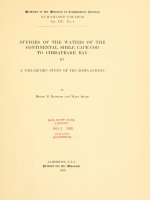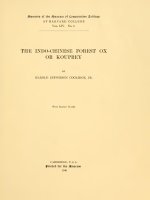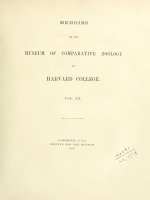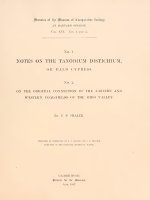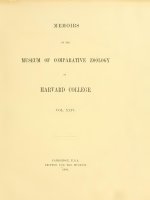Memoirs MCZ 5402
Bạn đang xem bản rút gọn của tài liệu. Xem và tải ngay bản đầy đủ của tài liệu tại đây (1.93 MB, 41 trang )
/IDemoirs of tbe flDuseum of Comparative ZoolOQp
AT
HARVARD COLLEGE
Vol. LIV. No.
2.
SOME ADDITIONAL FOSSIL ECHINI
FROM JAMAICA
BY
BENJAMIN WALWORTH ARNOLD
and
HUBERT LYAL\N CLARK
WITH FIVE PLATES
CAMBRIDGE,
IPrtnteD for tbe
U.
S. A.
/Duseum
December, 1934
SOME ADDITIONAL FOSSIL ECHINI
FROM JAMAICA
After
M.
C.
the publication of our
Z., 50, no. 1)
amount
large
Memoir on Jamaican
the senior author spent
of additional material.
Much
Mem.
Fossil Echini (1927,
some time
in
Jamaica and secured a
of this very naturally duplicates the
species already recorded but there are 13 specimens which represent apparently
new
and a few others which
species
seemed advisable to prepare
new forms and such
call for special
comment.
this report giving descriptions
has therefore
It
and
figures of the
additional information as will help to a l)etter understanding
of the fossil echini of Jamaica.'
The new
species here described represent nine genera of which one
is
new
to
and four others were not previously listed from Jamaica. It is a regrettable
that three of the new species must be referred to the heterogeneous group
science
fact
called Macropneustes. It
and
pedicellariae to
is
exceedingly
difficult in
the absence of spines, fascioles
draw generic lines among spatangoids satisfactorily. It is
however regrettable it maybe, that certain genera become
therefore unavoidable,
large
and unwieldly assemblages
of
forms which are not perhaps really closely
related.
In the following pages the same systematic sequence
is
used as in our Memoir.
Notes on previously described genera and species are thus intercalated in
natural position
among
the
new
We
forms.
prefer,
however, to mention here a
specimen of Ananchytes, which was found among stones and other
posed to be of local origin, in a
(i.e.
appearance
it
Hill.
of
to Jamaica, probably in
The death
curios, sup-
It is
an internal mould
mm.
long, 30
mm.
was obviously dug out of chalk and has the dark gray
similar specimens from England. So far as we can see this
seems almost certain that
England
'
Richmond
It
the English Ananchytes ovatus.
and
at
the cast of the interior of the test) and measures 37
and 22 mm. high.
is
box
of the senior author,
The genus
is
not
their
known from
the
West
wide
flinty
fossil
Indies,
specimen must have been brought from
a box of curios.
this
November
8,
1932, prevented the completion of the paper as
But this is now made possible through the
generous cooperation of Mrs. Arnold. Mr. Arnold was an unusual field worker and collector and his
enthusiasm was contagious. He secured the assistance of natives in Jamaica to a remarkable extent and
originally planned
and has
seriously delayed
its
publication.
to get together an extraordinary collection of Jamaican fossil echini. Neaily all of this, inthe holotypes and most of the paratypes of our new forms, is now in the Museum of Comparative Zoology, the generous gift of the Arnold estate. In the death of Mr. Ainold this museum loses a
was thus able
cluding
all
generous friend, and science the services of an unpretending and enthusiastic collector.
— H.
L. C.
JAJVIAICAN FOSSIL ECHINI
140
ECHINID.4E
SCOLIECHINUS AXIOLOGUS
Mem. M.
Arnold and Clark, 1927.
C.
Z., 50, p. 23.
A
badly weathered specimen of this species, previously known only from the
holotype, measures 27 mm. in diameter. The characteristic arrangement of the
pore-pairs
evident, but the tubercles are
is
stome with conspicuous
from what part
of
all
badly worn down. The large peri-
gill-cuts is a noticeable feature.
There
specimen came. ^'\L&
^a.be\
Jamaica
this
is
nothing to show
SQ-^.:
\AoUwrs
ECHINOMETRID.\E
ECHINOMETRA LUCUNTER
Echinus lucunter Lione, 1758. Syst. Nat., ed. 10, p. 665.
Echinomelra lucunter Loven, 1887. Bih. Svensk. Vet.-Akad. Handl., 13
A
(4), no. 5, p. 157.
perfectly fossihzed Echinometra, with the oral surface
still
imbedded
in a
fragment of open, porous hmestone, seems to be unquestionably identical with
common on
the recent species so
long, 34
each
arc,
mm.
the coast of Jamaica today. It measures 38
wide and about 20
in St.
high. There are as a rule 6 pore-pairs in
and only one with 7
Ehzabeth Parish.
a few have but
men was found
mm.
mm.
5,
is visible.
This interesting speci-
CLYPEASTRIDAE
Clypeaster antillarum
Cotteau, 1875.
We
Kongl. Sven. Vet. Akad. Hand]., 13, no.
with considerable hesitation, to this species, a Cl>T)easter with a
refer,
flat oral surface,
figure given
figs. 1
and
2)
6, p. 15.
a well-arched dorsal side
by Jackson
,
but
and
large petals,
which resembles the
(1922, Carnegie Inst. Washington, publ. no. 306, pi. 5,
differs in
having the test narrower, especially posteriorly. The
upper surface
is
badly weathered so that the details of the petals are obscured.
The specimen
is
100
gray
in color.
The
mm.
long, 78
exact locality
mm.
is
wide and 26
not known.
mm.
high,
and
is
light slate
\
,
^0*/^'
CLYPEASTRIDAE
Clypeaster eurychorus
Plate
mm.
Test 132
mm.
long, 114
ments are approximate
The highly arched
test
1, figs.
1
141
'
sp. nov.
and 2
mm.
wide and 51
high at apex; these measure-
owing to the defective condition of the specimen.
slopes more rapidly and uniformly anteriorly than posonly,
teriorly; apex a httle posterior to center; text thicker through interambula-
crum 5 than
mm. and
ambulacrum
in
3
is
nearly Hat for 20
then slopes quite abruptly to margin; apical system about 10
diameter markedly elevated,
center about 4
its
mm.
mm.
in
above the proximal part
Petaloid area very large covering about two-thirds of the dorsal
of the petals.
and V, obovate, 56 mm. long by 35 mm. wide, almost closed diswith poriferous areas nearly 10 mm. wide where widest and inter poriferous
surface; petals
tally,
posterior to the apex the test
;
area nearly 16
I
mm.
across; petals II
43 x 32 mm., open 3 or 4 mia. at
tip,
and interporiferous, 15 mm.; petal
others, about 56 x 32 nam.
was nearly
;
and IV shorter and more broadly obovate,
with poriferous areas about 8.5
III, relatively longer
the extreme tip
is
mm.
In
all
and narrower than the
wanting but apparently the petal
or quite closed; poriferous areas 8 or 9
poriferous barely 15
mm. across
mm.
across with the inter-
the petals the pore-pairs are crowded, 10-12 to
a centimeter, the ridges between the pairs carry a single series of about 10
tubercles.
pores
Whole tuberculation
5, fairly distinct,
of aboral surface rather close
about 5 or 6
Oral surface more or
less
mm. from
and
fine.
Genital
center of abactinal system.
concealed in matrix; so far as visible,
it is
quite flat
with no indication of concavity or even of a depression about the mouth, which
is
Periproct not certainly deterininable
wholly concealed.
about 4
mm.
Holotype (M. C.
definite locality is
This species
its
Z. 3,474)
center
is
9
mm. from
apparently,
posterior
end
it
is
of test.
and only specimen, from Jamaica but no more
known.
is
combined with the
distinctive.
and
in diameter
;
any other of the West Indian forms, the height
closed petals and the flat oral surface being sufficiently
quite unlike
large,
Whether the elevation and
position of the abactinal system
and
the abrupt slope of the posterior end of the test are constant features remains to
be shown but
if
they
are, the species is
the same group with duchassaingi
'
eOpix<^pos
=
unmistakable.
It
seems to belong in
MicheUn and ambigenus (Lamarck).
spacious, in reference to the big petals.
JAMAICAN FOSSIL ECHINI
142
FIBULARIIDAE
SiSMONDIA CRUSTULA
Hawkins, 1927.
We
Mem. M.
C.
Z., 50, p. 78.
are glad to report that a single specimen of this species
was secured
in
was not recorded.
1928, but the exact locality
SCUTELLIDAE
Encope homala
Plate
Test 115
mm.
ambulacrum
in
half of test
III; at
little
mm.
but
mm.
it is
is
its chief
features are
shaped, the axis of each ray about 6
pores set well
down
in
and possibly
;
it
madreporite conspicuously star-
long, with
each interambulacrum 2
ray of the madreporite; in interambulacrum
3
was never arched and only a
This system has been damaged by
evident
mm.
1
numerous
mm.
in 3,
and
more from the
tip of the
one right at the tip of the
in 4, a single pore as usual is present; in 5, there are
probably 2 pores but possibly only
Petaloid area about
or
fine pores; genital
there are at least 2 pores, probably
4; in 2, there are 2 pores, the larger
madreporic ray;
thick; greatest thickness
Test somewhat crushed and no
evident that
still
mm.
only 5 mm., and whole posterior
thick.
elevated at abactinal system.
crushing but
1
2, fig.
margin thickness
artificially
sp. no\'.
wide, and only 9
uniformly about 5
is
doubt flattened
very
long, 100
'
40%
1.
of dorsal surface; petals I
and V, 40 mm. long and
and IV, 32 mm. long, 12
mm. wide, open distally about I^o mm.; petals II
mm. wide, apparently nearly closed at tip; petal III, 36 mm. long, 13 mm. wide,
well open at tip, apparently for about 3 mm. Marginal notches probably presmm. deep and about 4 mm. wide; in II
ent in all ambulacra; in I and V, 5 or
and IV, 6 or 7 mm. deep and 5 or 6 mm. wide; in III, 10 nnn. deep, about 5
mm. wide and nearly or more probably quite clo.sed in at margin, forming a
kmule. Interambulacral lunule in area 5, about 20 mm. long, nearly 5 mm.
wide, its posterior end about 13 mm. from margin of test.
12
Oral surface wholly concealed by matrix. Color of specimen light gray-brown,
with interporiferous areas hghter and poriferous areas darker.
llolotype (M.
C Z. 3,475)
'
ifiaXoi
=
and only specimen, from the parish
flat, level, in
reference to the unusually
flat test.
of
Manchester.
NtJCLEOLITIDAE
This Encope
143
very different from any of the recent species of the genus,
is
nor do we find any of the
fossil
forms, of which a
number have
recently been de-
any nearer. Aside from the very flat test, the position of the
pores and the form of the lunules are very distinctive characters.
scribed,
genital
NUCLEOLITIDAE
Haimea
vs.
Patjropygus
Shortly after the pubUcation of our Memoir, Professor Hawkins kindly called
our attention to the fact that Lambert (1925,
232) had recorded
Haimea
caillaudi Michelin
Comp. Rev.
Soc. Geol. France, p.
from Spring Mount, Jamaica, and
seemed to be probable that our genus Pauropygus was a pure synonym of
Haimea. Through the great kindness of Senor Mario Sanchez Roig of Havana
it
we have
received one of the Spring
Haimea. There
elevatus.
is
no doubt that
Mount
it is
specimerLS identified
a
Careful comparison of MicheUn's description and figure with Jamaican
synonym
of
Haimea and P.
elevatus is
H.
caillaudi.
is
right,
list
fossil echini
become necessary and
number
of this
of
West
for convenience of other workers
we
them herewith:
Pauropygus Arnold & Clark, 1927 = Haimea Michelin, 1851, Rev. et Mag. Zool.,
Haimea caillaudi Michelin, I.e. p. 2, pi. 2, fig. 2.
Pauropygus alius Arnold & Clark becomes Haimea alia (A. & C.)
Oligopygus alvarezi Lambert & Sanchez Roig becomes Haimea alvarezi (L. & S. R.)
Pauropygus convexus Arnold & Clark becomes Haimea convexa (A. & C.)
Pauropygus cylindricus Arnold & Clark becomes Haimea cylindrica (A. & C.)
Pauropygus elevalus Arnold & Clark is a synonym of Haimea caillaudi Mich.
Pauropygus lalus Arnold & Clark becomes Haimea lata (A. & C.)
3.
Pauropygus
As a consequence
interesting discovery, certain changes in the nomenclature of a
Indian
as
a fairly typical example of our Pauropygus
specimens of Pauropygus have satisfied us that Lambert
is
by Lambert
no. 2, pp. 2
and
Type-species,
Pauropygus ovumserpenlis Arnold & Clark, i.e. Echinolanipas ovumserpentis Guppy,
Haimea ovumserpenlis (Guppy).
Pauropygus parvipetalus Arnold & Clark, becomes Haimea parvipeiala (A. & C.)
Pauropygus platypelalus Arnold & Clark becomes Haimea platypetala (A. &. C.)
Pauropygus pyramidoides Arnold & Clark becomes Haimea pyramidoides (A. & C.)
Pauropygus rotundus Arnold & Clark becomes Haimea rotunda (A. & C.)
Pauropygus rugosus Arnold & Clark becomes Haimea rugosa (A. & C.)
Pauropygus stenopetalus Arnold & Clark becomes Haimea stenopelala (A. & C.)
All of the specimens of
Haimea
collected in
Jamaica
into one or the other of the species already described.
and no individual whose
identification has caused
becomes
in 1928 fall very easily
There are no new forms
difficulty.
There are a
specimens of several of the rarer species but unfortunately
number
of additional
there
no additional material
is
any
1866,
of platypetala.
JAMAICAN FOSSIL ECHINI
144
CASSIDULIDAE
Cassidulus platypetalus
Plate
Test 34
of
mm.
mm.
long, 28
length and height
1, figs.
sp.
nov.
3-5
wide and 18
Surface so
is .53.
'
mm.
high; width
much weathered
thus about .80
is
that tubercles are visible
only in a part of interambulacrum 3; they are small, well-spaced and not peculiar.
Test broadly oval,
wider across petals
I
and
V
than
of test;
out; test
is
anterior to the
it is
Apical system distinctly excentric anteriorly, only 15
apex.
end
little
mm. from
anterior
no genital pores or other features of the apical system can be made
nearly flat apically and slopes abruptly, almost vertically to the
ambitus at anterior end, but posteriorly
it
slopes very gradually to the periproct
and then more abruptly to ambitus. Periproct conspicuous from above, 5 mm.
long and 4 mm. wide, with its posterior or lower margin 3 mm. from rear end of
test.
Petaloid area very large occupying about
ous areas approximately equal in
and scarcely
7
mm.
all
petals.
80%
of the aboral surface.
Petals I and V, about 15
Porifer-
mm.
long
wide, not quite closed at tip, with poriferous areas, each 1.5
mm. wide near middle; petals II and IV, more broadly oval, 14 mm. long, fully
7 mm. wide; with a somewhat attenuate tip open by about a millimeter; petal
III, longer and narrower than the others, about 16 mm. long and little more
than 6 mm. wide, the tip open by fully 1.5 mm.
Oral surface, concave along the axis III-5, especially near the mouth; peris-
tome
small, obscured
by matrix, about 15 mm. from anterior end
mm.
lodes conspicuous 5 to 6
long by 3
mm.
wide; bourrelets,
if
of test; phyl-
present, con-
by matrix. Color pale brown or dirty whitish.
The holotype (M. C. Z. 3,476) was the only specimen secured and there
cealed
is
no
record of the locality.
Cassidulus sphaeroides
Plate
Test 38
of length
'
TrXoT-iis
mm.
long, 36
and height
= broad
-
sphaeroides
=
is .65.
+7rtra\oi'
like
mm.
= a
1, figs.
wide, and 25
Surface so
'
sp. nov.
6-8
mm.
high; width
much weathered
petal, in refei'dice to the
there
is
is
thus about .95
no indication
notably wiile petals.
a sphere, in reference to the high test and nearly circular ambitus,
of
CASSIDULIDAE
145
tubercles or ornamentation except orally in interambulacrum 5 where a few
tubercles are visible,
and beside the matrix which covers most
some
there are tubercles and
pits to
greatest width, however, being
be seen. Test almost circular in outUne, the
back
ing apex nearly central and from
;
it
of the oral surface
of the apical system,
which
totally lack-
is
the test slopes almost uniformly in
all direc-
interambulacrum 5 abruptly truncate, the flattened area, however,
tions;
quite vertical but slopes a Uttle from
to ambitus.
is
not
upper margin downward and outward
its
Periproct very large and area around
it
depressed, conspicuous from
above owing to weathering, exact measurements cannot be given but apparently
;
the periproct
2
mm.
was
itself
at least 8
mm.
high and 6
mm.
wide; lower margin only
or less from rear end of test.
Petaloid area large, occupying about
72%
of the aboral surface.
Petals I
and V, about 18 mm. long and 6 mm. wide, the interporiferous area being only
a
trifle
over 2
mm.
damaged so that it is imopen; petals II and IV larger and
across; the tips of the petals are
possible to say whether they were closed or
mm.
wider, about 20
mm.
distinctly longer
than the anterior; interporiferous area 4
at tip
by about
1.5
long by 7
mm.;
petal III,
wide, with the posterior poriferous area
19 mm.
long, a
mm.
wide; petals open
mm.
over 5
trifle
wide, sUghtly
open at tip as poriferous areas converge but Uttle; in petals I, V and III, the
poriferous areas show no evident inequaUty but the condition of the tips does
not permit of certainty in the matter.
Oral surface almost wholly concealed by a considerable mass of matrix, so
that nothing can be determined as to position or appearance of peristome and
its
surroundings; apparently the lower surface of the test was nearly
there
may have
been considerable depression near mouth. Color dirty whitish.
The holotype (M. C.
Z. 3,477)
was the only specimen secured.
This species and the preceding represent a group of
from Jamaica,
surface.
It
easily recognized
may
place
and
not hitherto
known
position of the periproct on the dorsal
split off
from that somewhat heterogeneous group. But
be that with more and better preserved material,
them more
of test
by the
fossils
seems to us they are better referred to Cassidulus than to any of the
genera that have been
it
but
flat
accurately.
The two specimens
are so
it
will
be possible to
unUke each other
in the petals that they cannot be referred to the
same
in
form
species,
do we find any previously described cassiduloid to which either one may be
ferred. They make a very interesting addition to the Jamaican fauna.
nor
re-
JMIAICAN FOSSIL ECHINI
146
Rhynchopygus punctatus
Plate
Arnold and Clark, 1927.
One
Mem. M.
of the notable
Z., 50, p. 55.
specimens secured in 1928 was a fine adult of this rare
The specimen (M.
species.
C.
9-11
1, figs.
C. Z. 3,478)
is
41
mm.
high, almost double the size of the holotype.
species, depressed so as to be
out definite arrangement."
there
is
no overhang
of
The
concave in the long
with numerous, deep, more or
long, 31
periproct
is
6
axis,
mm.
interambulacrum 5 above
wide and 12
oral surface
is
mm.
typical of the
in diameter, with-
wide and 4
it,
mm.
conspicuously "punctate
less circular pits, .10-.2.5
The
mm.
mm.
yet the area
is
high and
distinctly
depressed.
It is
unfortunate that there
is
no label to indicate where
this
specimen was
secured.
HEMIASTERIDAE
HoMCEOPETALus
'
gen. nov.
Test ovate, depressed, with small petaloid area; apical system excentric
posteriorly;
all
petals shghtly sunken, III the least so; interporiferous areas very
narrow, practically wanting; petal III longer than the others, with pores notably smaller and less circular; periproct submarginal but size and position un-
known; peristome and other characters
genital pores unknown.
Type-species
This
:
— Homopopetalus
of oral surface
axiologus sp. nov.
the poor condition of the unique specimen,
position. There
is
no indication of
are, therefore, placing it in
of the test
appearance
'
of
a peculiar genus unhke any Recent or fossil spatangoid, but owing to
is
produced
unknown; number
may
we cannot be
=
family
we
While the flattened condition
be due in some sUght degree to pressure,
it is
evident from the
ambitus that no marked change of form has been
artificially.
oMoios
its
fascicles, nor of a subanal plastron, and
the Hemiasteridae.
of the plates at the
sure even of
similar, in reference to the fact that the five petals are so
much
alike.
HEMIASTERIDAE
147
HOMfEOPETALUS AXIOLOGUS
Plate
mm.
Test 63
is
long, 54
mm.
Sp. nov.
2 and 3
2, figs.
wide and 27
mm.
approximate only, owing to the condition
much
^
measurement
high; the vertical
of the oral surface,
but the height
is
than half the length and probably half the width is about the
normal condition; the width is nearly .90 of length. Test widest just in front of
certainly
less
and IV, somewhat narrower back of abactinal system, its general outline being rounded ovate. Apical system conspicuously excentric posteriorly,
being placed only about 25 mm. from posterior end of test. Genital pores and
petals II
all
other details of the apical system quite indeterminable.
Petaloid area small, only about half the aboral surface; petals
rounded ends and practical lack
their definite form, with closed,
poriferous area;
all
are
all
of
any
inter-
and V, the most so. III the least;
obUquely elongated and inconspicuous
somewhat depressed,
in petal III, the pores are relatively small,
notable for
I
while in the other petals they are large and round, but the circular form
is
un-
doubtedly exaggerated by weathering, as no doubt the size is also; petals I and
V are 18 mm. long by 5 mm. wide; II and IV are 20 x 5 mm.; and III is 25 x 5
mm. Interambulacrum
interambulacra 2 and
3 are quite
life,
between the
and
I
and
V
;
and
impossible to determine positively what conditions were in
distribution;
all
the interambulacra except 5 were rela-
Tuberculation of test has largely disappeared but
petals.
interambulacrum 3 enough
in size
rounded ridge between petals
1
4, but especially 2, are compressed into ridges while
but we are incUned to beUeve that
tively flat
in
flat; it is
5 forms a low,
present to show that
is
some
it
was more
of the tubercles are notably larger
or less irregular
than the great
majority but they show no definite arrangement.
In interambulacrum
5,
below the ambitus, there
long by 5
mm.
but this
doubtful; the area in question has
is
wide which
from the rear end
may
of the test
;
is
an oval area, about 7
mm.
possibly indicate the position of the periproct
its
posterior margin about 7
mm.
no other features of the oral surface can be made
out because of the condition of the specimen.
Color Ught brown and dirty
whitish.
The unique holotype (M. C.
Z. 3,479)
a label never having been written.
'
iiuiXoyos
=
It
was secured
has puzzled
at
an unrecorded
us, it is so unlike
remarkable, of obvious significance.
locality,
any other
JAMAICAN FOSSIL ECHINI
148
The
spatangoid we have seen.
general appearance reminds one strikingly of a
clypeastroid but the petals are very definitely those of a hemiasteroid.
not be confused with any other West Indian
LiNTHIA OBESA
mm.
and height
.95 of length
mm.
long, 71
mately at center,
4-6.
wide and 52
mm.
high; width
rapidly to ambitus on
away
falling
Sp. UOV.
flatter.
Petals I
Inter ambulacra 5,
all sides.
2 and 3 forming low rounded ridges adapically, particularly
conspicuously wider and
thus more than
is
Test notably high, with apical system approxi-
.70.
is
fossil.
2, figs.
Plate
Test 74
'
It will
5, wliile 1
and 4 are
and V, about 25 mm. long by 5 mm.
wide, diverging so httle that their distal tips are only about 20 nrni. apart;
petals II
and IV longer and wider, probably about 30-35 mm. long by 7 mm.
by matrix accurate
measurements cannot be made; they run forward, more than outward, and their
40 mm. long by 7 mm.
tips were about 45 nun. from each other; petal III is about
wide, but their distal parts are so
wide but
is
more or
damaged
or concealed
with matrix which conceals
less fiUed
petals are deeply sunken. Genital pores
and other
its distal
end. All the
details of the abactinal
system
cannot be made out.
Ambitus broadly rounded,
ill
defined posteriorly where the test
with the flattened area sloping somewhat adorally; there
pression of the test at the ambitus in
ambulacrum
III.
is
apparently some de-
Periproct not detectable
but doubtless on the truncate, obUque surface of the rear of the
face of test not at
all
flattened but notably swollen
posterior part of the sternum. Peristome concealed
depressed, very far forward,
end
there a
number
while orally
of
No
of test.
test.
Oral sur-
and rounded, especially the
by matrix but
anterior margin not over 12-15
e-\adently httle
mm. from
anterior
indication of tubercles remains except at anterior end of test;
of rather
much
its
truncate
is
larger
crowded small tubercles are
visible
and rather widely spaced tubercles
above the ambitus
may
be seen. Color
specimen Ught gray.
Holotype,
There
M.
may
C. Z. 3,482.
be room for difference of opinion as to whether this species
true Linthia or not but
it
seems nearer to L. trechmanni than
West Indian spatangoid, and
'
obesus
=
it is
there seems no objection to referring
fat, stout, in
reference to the striking form of the test.
a
any other
to the same
to
it
is
HEMIASTERIDAE
genus.
The form
149
of the test is so distinctive in obesa that it will not be confused
with any other species, and we see no indication that this form
is
the result of
pressure or any other external conditions.
Cyclaster sterea
Plate
3, figs.
'
sp.
nov.
4 and 5
Test distorted by pressure along the antero-posterior axis but the distortion
seems to be chiefly
if
not wholly in front of the apex and on the right hand side
in other words the right anterior quarter of the test
vertical axis so as to
make
is
;
crowded back against the
the anterior end of the fossil an almost vertical surface
mm. but
we estimate that in life it was from 95 to 100 mm.; the width is 86 mm. across
the apex, where it is widest, and in Ufe was about the same; height 72 mm. but
about 50
mm.
high; at present the length of the test
only about 85
is
was probably quite a little less, as there is good reason to think that the
pressure which so evidently shortened the long axis has increased the vertical.
in
life
Nothing can be made out as to genital pores or details of abactinal system;
periproct and most of oral surface concealed by matrix; peristome wanting, and
worn and
tuberculation of test so
deficient as to be insignificant.
Petaloid area large, occupying most of the highly arched upper surface.
Apex probably
V
nearly 55
anterior to center of test, at least to
mm.
long,
mm.
about 6
some
extent.
Petals I and
wide, deeply sunken and largely
filled
with
matrix; interporiferous area insignificant; tips closed; distance of tips from each
other, across
interambulacrum
5,
about 37
mm.
Petals II and
IV extend out
opposite to each other, almost at right angles to long axis of test, curving forward
just a little distally; they are filled with matrix but
by 6 mm. wide. Ambulacrum
III
is
not at
pressed but probably at the ambitus
Oral surface not at
of the specimen,
all
it
all
measure about 50
petaloid and
it is
impossible to say
;
long
only slightly de-
made a broad and shallow
flattened but surprisingly convex
however,
is
mm.
concavity.
owing to the condition
how much
of the convexity
is
natural. Color pale gray.
Holotype,
M.
C. Z. 3,483.
In view of the condition of this unique specimen
assign
it
fossil,
we
to a genus, but as
feel it is
it is
ffrepea
=
by no means easy
so markedly different from
important to give
•
it is
it
any other Jamaican
a name. It seems to
massive; of obvious significance.
to
fall
into the genus
JAMAICAN FOSSIL ECHINI
160
Cyclaster somewhat better than into any of the related groups but
from the two species
different
from Cuba, and
will
of Cyclaster
it
is
quite
which Sanchez Roig describes (1926)
not be confused with any other West Indian echinoid.
ViCTORIASTER JAMAICENSIS
Plate
3, figs.
'
Sp. nOV.
1-3
Test so badly damaged that the following measurements are only approxiwill give a fair idea of the
mations or estimates, but they
of this fine species.
of the original test,
93
mm.
mm.
The specimen is an internal mould, i.e. a cast of the interior
which is now entirely lacking. Length, through III-5, about
but measured from the anterior margin
mm. width
nearly 105
evidently
;
mm.
height at apex 40
;
and V, 28
mm.
this
side of III,
perhaps as
much
by a
it is
as 125
Apical system excentric posteriorly, about 62
abruptly and almost uniformly on
I
on either
of test
much more than
of test, concealed
from anterior margin
Petals
extraordinary character
mm.
Test slopes rather
bit of matrix.
to a moderately thick margin.
all sides
long by 6 nam. wide, deeply depressed, with practi-
no interporiferous area, diverging very considerably from each other so
that their tips are about 30 mm. apart. Petals II and IV, nearly 50 mm. long by
cally
7
mm.
distal
wide, markedly depressed near middle but almost flush with test at both
distal third widest portion of petal, its sides almost
and proximal ends;
Petal III, very wide and very deeply sunken distally, about 60
parallel.
long and 15
surface quite
mm.
flat,
wide, marginal notch at ambitus about 12
projecting correspondingly.
Sternum
well
and
4,
it,
with
considerably sunken, the labrum
Peristome about 18
mm. from
anterior margin about 12
III.
1
Oral
deep.
but peristome, and the ambulacra as they approach
adjoining parts of interambulacra
crum
mm.
mm.
mm.
wide and 7
mm.
long, its
the ambitus in the depression of ambula-
marked, about 50
mm.
long by 30
mm.
Color
wide.
dirty yellowish-brown.
Holotype,
M.
C. Z. 3,484.
This very remarkable spatangoid seems to us to be undoubtedly congeneric
with Victoriaster lamberti Sanchez Roig from Cuba. Details
the oral surface
that
ingly
it is
make
it
clear that the
nearly related to
its
Jamaican form
Cuban congener admits
unUke any other .lamaican
species.
is
jamaicensis
=
and
of
a different species, but
of little doubt.
It
is
strik-
Only the damaged holotype was
secured.
^
of the petals
of Jam.aica, of obvious .siKnificance.
SPATANGIDAE
151
SPATANGIDAE
Antillaster arnoldi
H. L. Clark, 1927,
It is
is
Arnold and Clark,
in
Mem. M.
C.
Z., 50, p. 62.
very interesting to find another specimen of this huge species even
not nearly so well preserved as the holotype. It was secured at Spring
close
by the spot where the
original
Test 100
mm.
long,
90
mm.
1
sp. nov.
and 2
4, figs. 1
mm.
wide and 43
high,
more or
and decreased the height pressure has
;
also closed
Apex markedly
the front margin of the test; even in
more or
anterior, only
life its
less distorted
by
increased the width
pressure which has undoubtedly shortened the long axis,
tions of the paired petals.
Mount
specimen was discovered.
Macropneustes dyscritus
Plate
if it
less
the proximal por-
mm. back
about 25
anterior position
of
must have been
conspicuous. Details of the apical system, periproct and peristome are concealed
by
distortion, weathering or matrix.
III are also lacking.
Oral surface
elevated and convex,
all visible
Unpaired petal and
details of
ambulacrum
the posterior part of sternum somewhat
flat,
portions covered with a very uniform and close
tuberculation.
Petals
I
sunken, and
hardly 35
mm.
V
and
about 55
now almost
mm.
mm.
probably about 7
long,
or quite closed
apart; details obscured
by
less
by matrix. Petals
M.
and IV about 48
wide but deeply sunken
;
Color light gray.
C. Z. 3,485.
In the appearance of the petals
this
unique specimen reminds us of
tus but the difference in the shape of the test
should be referred to that species. With
sure in both species,
is
mm.
II
completely closed by pressure except distally they run out
at right angles to the long axis of the test.
Holotype,
wide but deeply
pressure, except near tips which are
long, apparently reaching to ambitus, fully 7
and now more or
mm.
there any other
we think that
in Ufe
all
is
so great,
we cannot
due allowance for the
nearly allied and we, therefore, reluctantly
to
= hard
believe
it
effects of pres-
which the present specimen
name
it
and place
heterogeneous genus Macropneustes.
bvaKfiiros
angus-
they must have been quite unUke. Nor
West Indian sea-urchin
'
M.
to determine, of obvious application.
it
is
in the already
JAMAICAN FOSSIL ECHINI
152
Macropneustes sinuosus
Plate
mm.
Test about 87
but as the specimen
We
is
estimate that in
sp. nov.
figure 3
4,
more than 100 mm. wide and about 40 mm.
long,
badly distorted
life
'
by
pressure, these figures have
the individual was about 95
mm.
little
high,
value.
long and nearly as
wide, while the height was less than half as much. Entire posterior end and whole
oral surface completely lacking, occupied
not at
all
by matrix. Ambulacrum
by 6 mm. wide, with no interporiferous
areas almost parallel the two petals are about 55 mm. apart
fully 55
mm.
long,
;
II
and IV run out
at their tips.
of the specimen; apparently
All paired petals distinctly but not
long.
and
V
Petals
at right angles to the long axis of the test; they are similar to
owing to the damaged condition
mm.
I
area, the poriferous
the posterior petals in width and general appearance but their length
45
III, wide,
slightly depressed even at ambitus; petals
petaloid and very
is
in
doubt
they were about
markedly depressed. Inter-
ambulacral plates of dorsal side few and large; those near ambitus are 20-30
mm.
mm.
wide and 10-12
area,
but particularly in
Median
high.
1,
4 and
5,
M.
This feature
very conspicuously sinuate.
would probably not be so conspicuous
fawn or dirty white.
Holotype,
sutural line in each interambulacral
in well preserved specimens.
Color light
C. Z. 3,486.
Here again we have a unique specimen that seems to be better referred to
Macropneustes than to any other genus, which nevertheless cannot be assigned
any species hitherto described. It is undoubtedly seriously distorted, but
nevertheless it was certainly low and wide with very long and only slightly deto
We
pressed petals.
of
cannot see that
it is
very near any of the numerous species
Macropneustes we have handled.
Macropneustes stenopetalus
Plate
Test 74
mm.
half the length
^
sinuosus
(TTifis
=
=
wide;
its
4 and
sp. nov.
5.
height
is
apparently a
trifle less
than
but owing to matrix on the lower surface no accurate measurement
can be made. Test rather
'
mm.
long and 68
4, figs.
^
full of
narrow
fiat
bendings,
in
+ TtTaXov =
both above and below with thick well rounded marreference to the conspicuously sinuous iiiterradial sutures.
petal, in reference to the
narrow
petals.
SPATANGIDAE
Apical system excentric anteriorly
gin.
of test. Tuberculation of test rather close
less
153
mm. from
than 30
but irregular with very small, small and
rather large tubercles; the large tubercles are found in
show no
areas but
V only
Petals I and
mm.
about 35
a
mm.
mm. high by 6 mm.
arrangement; they are rather more than a Yl
definite
wide, but partly concealed
tips
the interambulacral
all
Periproct just below posterior margin of test, about 7
across.
anterior margin
by matrix.
little
mm.
depressed, 35
long by only 5
mm.
wide, their
no interporiferous areas. Petals II
long, diverging widely from the long axis
apart, with practically
mm.
and IV
similar,
of test
but curving slightly forward especially near
but only about 30
Ambulacrum
tip.
III, not
and barely sunken, except at ambitus, where there is an evident
Peristome and whole lower surface concealed by
though shallow depression.
at all petaloid,
matrix. Color light gray.
Holotype,
M.
C. Z. 3,487.
This specimen, both by
Spatangus but the petals
we have
that
form and tuberculation reminds one at once
are, of course,
very different.
here an undescribed species, and
we
other forms that
well in
its
it
are referring to Macropneustes.
There seems no doubt
apparently belongs with the
At any
Plate
mm.
Test 68
long, 63
mm.
1
will not fit as
5, figs.
4-6
wide and only 28
mm.
high, broadly ovate with the
and the posterior end deeply notched in its present condihighest anterior to the apical system and posterior to that point
tion, the test is
;
markedly and rather suddenly depressed, but
is artificial
which
it
sp. nov.
anterior end truncate
sion
rate
any other genus.
Metalia dubia
is
of
is
and that the
test sloped gradually
it is
probable that this depres-
backward
to the posterior end,
truncate and largely occupied by the very large, markedly depressed
periproctal area, 15
mm.
high and 14
mm.
wide.
Anterior end and sides of test
badly weathered, leaving no details of structure. Oral surface covered by matrix.
Petals
I
and
V
about 36
mm.
long and nearly 10
mm.
wide; interporiferous
area insignificant and tips of petals closed; they are but slightly depressed dis-
and the rather marked depression proximally would seem to be artificial;
they are markedly curved, diverging much from each other near the apical systally
"
dvHtyia
=
doubtful, in reference to our uncertainty regarding
its
true status.
JAMAICAN FOSSIL ECHINI
154
tem, then running more nearly parallel for a time and then diverging again at
tip.
Petals II and
mm.
long by 9
IV
mm.
are very badly weathered but were apparently about 32
wide; they are scarcely at
all
depressed, run out at almost
right angles to the long axis of the test, but curve forward a trifle at tip; at base
they are very narrow, the posterior margin is nearly straight, while the anterior
margin diverges anteriorly and is a trifle curved. Ambulacrum III was apparently not petaloid and was but slightly depressed even at ambitus.
Color dull
yellow.
Holotype,
M.
C. Z. 3,488.
In spite of
its
poor condition we think this specimen
in
view
is
certainly not the
of its general
form and the
same
petals,
it
is
entitled to a
name and
well be put in Metalia.
may
But
it
species as the following (M. jamaicensis) for the shape
of the test, the periproct,
and the petals are
all
very different from the better
preserved holotype of that species.
Metalia jamaicensis
Plate
Test 81
posteriorly,
mm.
long, 71
5, figs.
mm. wide and
•
sp.
nov.
1-3
45
mm.
and evidently, but not deeply, notched
high, broadly oval, truncate
in front, in
ambulacrum
Test highest anterior to apical system in interambulacra 2 and
abruptly to the front
3,
III.
sloping very
and very gradually to the posterior end. Details
of apical
system cannot be made out. Periproct about 11 mm. high by 8 mm. wide, but
its outlines are indistinct as the whole rear end of the test is badly weathered; for
no details of the subanal plastron can be made out, though there are
indications of its presence. Oral surface of test rather flat, but the sternum shows
this reason
an evident, though rounded keel, the rear end of which is about 15 mm. from the
end of the test itself. Peristome very Uttle depressed, about 6 mm. long by 14
mm.
wide, with the labrum only moderately projecting; anterior margin of
mm. from anterior end of test.
and V about 35 mm. long and 6 mm. wide,
peristome about 15
Petals I
a
little
depressed; inter-
poriferous area about as wide as one poriferous; petals narrower
and closed at
two petals are about 4 mm. apart at their proximal ends and only 30 mm.
the distal tips. Petals II and IV, more or less buried in matrix but apparently
tip; the
at
about 30
'
mm.
jamaiccnaix
long and 5
=
mm.
wide,
of .Jamaica, because
it is
somewhat depressed; they run outward and
the
first
indubitable Metalia to be found in Jamaica.
SPATANGIDAE
a
little
155
Ambulacrum
forward but do not seem to be curved.
III not petaloid,
almost flush with apical system but becoming quite deeply sunken distally,
forming a conspicuous marginal notch at ambitus; extreme anterior end of test
broken and badly weathered. Fascicles almost indistinguishable except around
where the characteristic peripetalous
tip of petal II
allies) is
very distinct for some 15 mm.;
of test, so far as
it still
about
it is
fascicle of
1.5
mm.
Metalia (and
its
wide. Tuberculation
shows, rather close and uniform except in interambulacra
ambulacrum
2 and 3 along the margins of
III where conspicuously larger, but
not big, tubercles are evident. Color pale gray or dirty whitish.
Holotype,
M.
C. Z. 3,489.
The resemblance
of this notable fossil to Metalia sternalis, the
of the Indo-Pacific region
generic.
It
is
so striking as to leave
no doubt
Recent species
of their being con-
true that sternalis shows considerable diversity in shape of test,
is
position of apex
and confluence
are specimens in the
Museum
of petals I
of
and
V at their proximal ends but there
Comparative Zoology which have the
almost exactly the shape and proportions shown by this Jamaican
rule, the
apex
is
distinctly
more anterior
in sternalis
test of
fossil.
As a
than in jamaicensis and
inter-
and 4 are noticeably higher near the apical system. The really important difference between the two species is, however, in the posterior petals;
in sternalis these are more or less confluent proximally, while in jamaicensis they
ambulacra
1
are well separated throughout their length.
Metalia in the fossiliferous rocks of Jamaica
is
The occurrence
of so typical a
of the greatest interest and forms
another link between the West Indian and Indo-Pacific faunas.
EUPATAGUS ALATUS
Arnold and Clark, 1927.
A
Mem. M.
C.
Z., 50, p. 63.
notable specimen of this species
is
exceptionally high and shows only the
posterior pair of genital pores; in other respects
somewhat
it is
evidently to be referred to
by pressure which has pushed the right side
forward a little and possibly diminished the width and increased the height a
little the apparent absence of genital pores in 2 and 3 may be due to a displacealatus.
It
is
distorted
;
ment
The
of plates
due to
this
test measures, as it
is,
same
41
pressure, but this does not
mm.
long, 33
mm.
wide and 26
the measurements were probably about 40 x 35 x 25
mm. As
in alatus is only a little over half the length
and
individual
almost white.
is
very conspicuous. Its color
is
is
seem
not rarely
to us assured.
mm.
high; in
life
the normal height
less
than that,
this
JAMAICAN FOSSIL ECHINI
156
EUPATAGUS GRANDIFLORUS
Euspalangus grandiflorus Cotteau, 1875. Kongl. Sven. Vet. Akad. Handl.,
Eiipatagiis grandiflorus Jackson, 1922. Carnegie Inst. Publ. 306, p. 89.
13, no. 6, p. 45.
The discovery of this fine species in Jamaica is very interesting, as it was
previously known only from a single specimen taken in the Eocene limestone
of St. Bartholomew. The present specimen is a trifle larger than the holotype as
it is
by
about 80
mm.
pressure, but
therefore,
much
important part
specimen, but
or
less.
it
At any
its
long by 60
mm.
wide.
It
has been damaged and distorted
normal height was apparently about 35
flatter
mm.
It
is
evidently,
than Cotteau's specimen, and we do not believe that any
of the difference in height is
seems to us that the holotype
due to
may
species.
depression in our
possibly be compressed
rate the petals are so characteristic
Jamaican specimen belongs to Cotteau's
artificial
we cannot doubt
more
that this
EXPLANATION OF PLATES
All figures are natural size
The
and represent the holotypes, excepting only Rhynchopygus punclalus.
side views are all of the left side.
PLATE
1
PLATE
Fig.
Fig.
Fig.
Fig.
1,
1.
Clypeaster eurychorus Arnold
Aboral view.
2.
Side view.
2.
and Clark.
3-5. Cassidulus platypetalus Arnold
3. Aboral view.
4.
Oral view.
5.
Side view.
6-8. Cassidulus sphaeroides Arnold
6. Aboral view.
7.
Oral view.
8.
Side view.
and Clark.
and Clark.
9-11. Rhynchopygus punclalus Arnold
9. Aboral view.
10.
Oral view.
11.
Side view.
and Clark.
1
MEM MUS COMP ZOOL.
ARNOLD AND CLARK JAMAICAN FOSSIL
n.
-
>
-
• 'if
C4^.
vC
•
^--^
W'^&M^^.
THE HELIOTYPe CORP. BOSTON
ECHINI. PLATE
1
